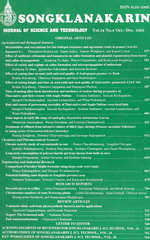ThaiScience
ThaiScience
SONGKLANAKARIN JOURNAL OF SCIENCE & TECHNOLOGY
Volume 43, No. 01, Month JANUARY, Year 2021, Pages 275 - 282
Features of jatropha curcas seed oil in relation to different pollination methods
Nilubol Nuanjunkong, Chakrit Tongurai, Jason T. C. Tzen, Pei-Luen Jiang, Upatham Meesawat
Abstract Download PDF
Physic nut (Jatropha curcas L.) is an attractive feedstock for producing standard-satisfied biodiesel. This study aimed to fill a knowledge gap of some aspects on fruit and seed biology of this biodiesel plant, by determining whether or not the pollination method affected seed oil accumulation and the development of fruit, embryo and endosperm as well as lipid storage in embryo and endosperm. For seed oil content, no significant difference was observed among open, cross-, self- and non-pollinated (apomixis) seeds. The maximum fruit and seed set, and the highest content of oleic acid were obtained from open pollination. The fruit diameter growth was well fit by a single sigmoid shape (R2 = 0.90). The contents of oil and oleic acid were higher in the endosperm than in the embryo. The oil bodies isolated from both embryo and endosperm tissues mainly contained triacylglycerol (TAG) and integrated proteins termed caleosins and oleosins.
Keywords
pollination method, oil content, oleic acid, oil body, Jatropha seedSONGKLANAKARIN JOURNAL OF SCIENCE & TECHNOLOGY
Published by : Prince of Songkla University
Contributions welcome at : http://rdo.psu.ac.th
